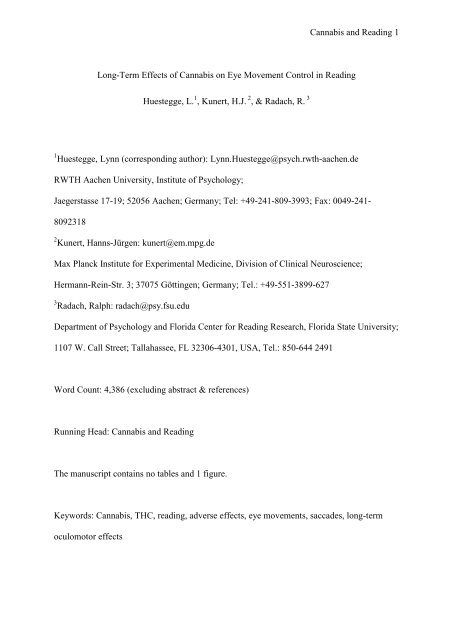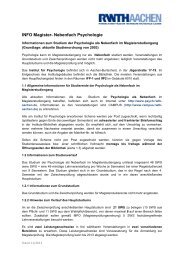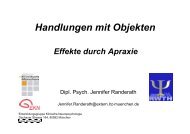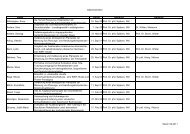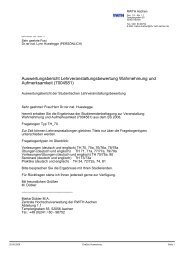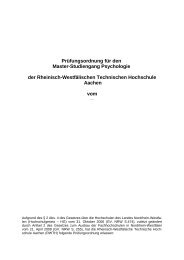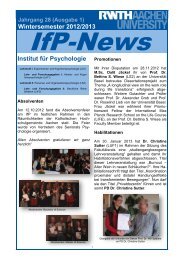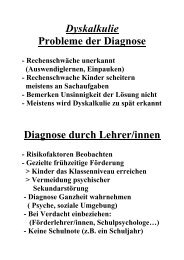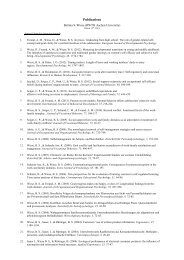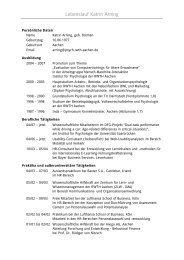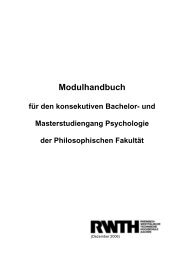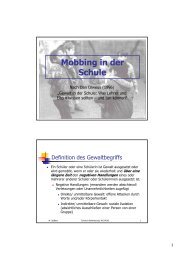Long-term effects of cannabis on the oculomotor system
Long-term effects of cannabis on the oculomotor system
Long-term effects of cannabis on the oculomotor system
You also want an ePaper? Increase the reach of your titles
YUMPU automatically turns print PDFs into web optimized ePapers that Google loves.
Cannabis and Reading 1<br />
<str<strong>on</strong>g>L<strong>on</strong>g</str<strong>on</strong>g>-Term Effects <str<strong>on</strong>g>of</str<strong>on</strong>g> Cannabis <strong>on</strong> Eye Movement C<strong>on</strong>trol in Reading<br />
Huestegge, L. 1 , Kunert, H.J. 2 , & Radach, R. 3<br />
1 Huestegge, Lynn (corresp<strong>on</strong>ding author): Lynn.Huestegge@psych.rwth-aachen.de<br />
RWTH Aachen University, Institute <str<strong>on</strong>g>of</str<strong>on</strong>g> Psychology;<br />
Jaegerstasse 17-19; 52056 Aachen; Germany; Tel: +49-241-809-3993; Fax: 0049-241-<br />
8092318<br />
2 Kunert, Hanns-Jürgen: kunert@em.mpg.de<br />
Max Planck Institute for Experimental Medicine, Divisi<strong>on</strong> <str<strong>on</strong>g>of</str<strong>on</strong>g> Clinical Neuroscience;<br />
Hermann-Rein-Str. 3; 37075 Göttingen; Germany; Tel.: +49-551-3899-627<br />
3 Radach, Ralph: radach@psy.fsu.edu<br />
Department <str<strong>on</strong>g>of</str<strong>on</strong>g> Psychology and Florida Center for Reading Research, Florida State University;<br />
1107 W. Call Street; Tallahassee, FL 32306-4301, USA, Tel.: 850-644 2491<br />
Word Count: 4,386 (excluding abstract & references)<br />
Running Head: Cannabis and Reading<br />
The manuscript c<strong>on</strong>tains no tables and 1 figure.<br />
Keywords: Cannabis, THC, reading, adverse <str<strong>on</strong>g>effects</str<strong>on</strong>g>, eye movements, saccades, l<strong>on</strong>g-<str<strong>on</strong>g>term</str<strong>on</strong>g><br />
<strong>oculomotor</strong> <str<strong>on</strong>g>effects</str<strong>on</strong>g>
Cannabis and Reading 2<br />
Abstract<br />
Cannabis is known to produce substantial acute <str<strong>on</strong>g>effects</str<strong>on</strong>g> <strong>on</strong> human cogniti<strong>on</strong> and visuomotor<br />
skills. Many recent studies additi<strong>on</strong>ally revealed ra<strong>the</strong>r l<strong>on</strong>g-lasting <str<strong>on</strong>g>effects</str<strong>on</strong>g> <strong>on</strong> basic<br />
<strong>oculomotor</strong> c<strong>on</strong>trol, especially after chr<strong>on</strong>ic use. However, it is still unknown to what extent<br />
<strong>the</strong>se deficits play a role in everyday tasks that str<strong>on</strong>gly rely <strong>on</strong> an efficient saccade <strong>system</strong>,<br />
such as reading. In <strong>the</strong> present study, eye movements during sentence reading <str<strong>on</strong>g>of</str<strong>on</strong>g> 20 healthy<br />
l<strong>on</strong>g-<str<strong>on</strong>g>term</str<strong>on</strong>g> <str<strong>on</strong>g>cannabis</str<strong>on</strong>g> users (without acute THC-intoxicati<strong>on</strong>) and 20 c<strong>on</strong>trol participants were<br />
compared. Analyses focused <strong>on</strong> both spatial and temporal parameters <str<strong>on</strong>g>of</str<strong>on</strong>g> <strong>oculomotor</strong> c<strong>on</strong>trol<br />
during reading. <str<strong>on</strong>g>L<strong>on</strong>g</str<strong>on</strong>g>-<str<strong>on</strong>g>term</str<strong>on</strong>g> <str<strong>on</strong>g>cannabis</str<strong>on</strong>g> users exhibited increased fixati<strong>on</strong> durati<strong>on</strong>s, more<br />
revisiting <str<strong>on</strong>g>of</str<strong>on</strong>g> previously inspected text, and a substantial prol<strong>on</strong>gati<strong>on</strong> <str<strong>on</strong>g>of</str<strong>on</strong>g> word viewing times,<br />
which were highly inflated for l<strong>on</strong>ger and less frequent words. The results indicate that<br />
relatively subtle performance deficits <strong>on</strong> <strong>the</strong> level <str<strong>on</strong>g>of</str<strong>on</strong>g> basic <strong>oculomotor</strong> c<strong>on</strong>trol scale up as task<br />
complexity and cognitive demands increase.
Cannabis and Reading 3<br />
Introducti<strong>on</strong><br />
Cannabis is a comm<strong>on</strong>ly used drug that produces acute <str<strong>on</strong>g>effects</str<strong>on</strong>g> <strong>on</strong> percepti<strong>on</strong>,<br />
cogniti<strong>on</strong>, and behavior (see Solowij, 1998) through its interacti<strong>on</strong> with an endogenous<br />
cannabinoid receptor <strong>system</strong> (CN-1) that is widely distributed across <strong>the</strong> CNS (Herkenham et<br />
al., 1990; Glass et al., 1997). Recent research indicated that chr<strong>on</strong>ic <str<strong>on</strong>g>cannabis</str<strong>on</strong>g> use may also<br />
result in l<strong>on</strong>g-<str<strong>on</strong>g>term</str<strong>on</strong>g> <str<strong>on</strong>g>effects</str<strong>on</strong>g>, usually defined as persisting <str<strong>on</strong>g>effects</str<strong>on</strong>g> after at least <strong>on</strong>e day <str<strong>on</strong>g>of</str<strong>on</strong>g><br />
abstinence (Pope et al., 1995). Several well-designed studies (see G<strong>on</strong>zales et al., 2002, for<br />
corresp<strong>on</strong>ding design criteria) c<strong>on</strong>sistently revealed two major sources <str<strong>on</strong>g>of</str<strong>on</strong>g> cognitive l<strong>on</strong>g-<str<strong>on</strong>g>term</str<strong>on</strong>g><br />
impairment, namely a decrease <str<strong>on</strong>g>of</str<strong>on</strong>g> attenti<strong>on</strong>-related functi<strong>on</strong>s (e.g., Fletcher et al., 1996; Pope<br />
& Yurgelun-Todd, 1996; Cr<str<strong>on</strong>g>of</str<strong>on</strong>g>t et al., 2001), and reduced memory performance (Fletcher et<br />
al., 1996; Rodgers, 2000; Solowij & Battisti, 2008; Solowij et al., 2002; Lamers et al., 2006).<br />
In <strong>the</strong> present study, we report evidence for l<strong>on</strong>g-<str<strong>on</strong>g>term</str<strong>on</strong>g> <str<strong>on</strong>g>effects</str<strong>on</strong>g> <str<strong>on</strong>g>of</str<strong>on</strong>g> chr<strong>on</strong>ic <str<strong>on</strong>g>cannabis</str<strong>on</strong>g> use <strong>on</strong><br />
<strong>oculomotor</strong> c<strong>on</strong>trol processes in reading.<br />
Efficient <strong>oculomotor</strong> c<strong>on</strong>trol is a prerequisite for a vast array <str<strong>on</strong>g>of</str<strong>on</strong>g> vital everyday tasks<br />
like navigati<strong>on</strong> in traffic (e.g., Huestegge et al., in press), reading (Radach & Kennedy, 2004;<br />
Rayner, 1998), and visual search (e.g., Huestegge et al., 2002). Previous research <strong>on</strong> <strong>the</strong><br />
<str<strong>on</strong>g>effects</str<strong>on</strong>g> <str<strong>on</strong>g>of</str<strong>on</strong>g> <str<strong>on</strong>g>cannabis</str<strong>on</strong>g> <strong>on</strong> eye movement c<strong>on</strong>trol revealed both acute and l<strong>on</strong>g-<str<strong>on</strong>g>term</str<strong>on</strong>g> <str<strong>on</strong>g>effects</str<strong>on</strong>g>. For<br />
example, acute <str<strong>on</strong>g>effects</str<strong>on</strong>g> <str<strong>on</strong>g>of</str<strong>on</strong>g> <str<strong>on</strong>g>cannabis</str<strong>on</strong>g> were studied in a pre-post design involving <strong>the</strong> executi<strong>on</strong><br />
<str<strong>on</strong>g>of</str<strong>on</strong>g> basic visually and memory guided eye movements in n<strong>on</strong>-regular users (Pl<strong>on</strong>er et al.,<br />
2002). As <strong>on</strong>e key result, saccade latencies <str<strong>on</strong>g>of</str<strong>on</strong>g> visually guided saccades were increased (12<br />
ms) and amplitudes <str<strong>on</strong>g>of</str<strong>on</strong>g> memory guided saccades were greater two hours after oral drug intake<br />
compared to baseline testing. However, <strong>the</strong> <str<strong>on</strong>g>effects</str<strong>on</strong>g> were ra<strong>the</strong>r small and it remained unclear<br />
whe<strong>the</strong>r such subtle deficits might persist for l<strong>on</strong>ger periods <str<strong>on</strong>g>of</str<strong>on</strong>g> time (especially in chr<strong>on</strong>ic<br />
users), and whe<strong>the</strong>r <strong>the</strong>y are meaningful in <strong>the</strong> c<strong>on</strong>text <str<strong>on</strong>g>of</str<strong>on</strong>g> everyday tasks.<br />
A recent study in our lab (Huestegge et al., 2009) compared performance <str<strong>on</strong>g>of</str<strong>on</strong>g> chr<strong>on</strong>ic<br />
users without acute intoxicati<strong>on</strong> and <str<strong>on</strong>g>of</str<strong>on</strong>g> c<strong>on</strong>trol participants in a series <str<strong>on</strong>g>of</str<strong>on</strong>g> <strong>oculomotor</strong>
Cannabis and Reading 4<br />
paradigms, similar to <strong>the</strong> work <strong>on</strong> acute <str<strong>on</strong>g>effects</str<strong>on</strong>g> by Pl<strong>on</strong>er et al. (2002, see above). In harm<strong>on</strong>y<br />
with <strong>the</strong>ir work, we also found increased latencies <str<strong>on</strong>g>of</str<strong>on</strong>g> visually guided saccades (related to an<br />
impairment <str<strong>on</strong>g>of</str<strong>on</strong>g> <strong>the</strong> programming phase <str<strong>on</strong>g>of</str<strong>on</strong>g> saccades), and for increased saccade amplitudes to<br />
memorized saccade locati<strong>on</strong>s (related to an impairment <str<strong>on</strong>g>of</str<strong>on</strong>g> visual working memory).<br />
Fur<strong>the</strong>r studies suggested that <strong>the</strong>se ra<strong>the</strong>r subtle deficits in <strong>oculomotor</strong> c<strong>on</strong>trol may<br />
scale up as task complexity increases. In a study by Ehrenreich et al. (1999), 99 l<strong>on</strong>g-<str<strong>on</strong>g>term</str<strong>on</strong>g><br />
users were tested with various neuropsychological assessments. <str<strong>on</strong>g>L<strong>on</strong>g</str<strong>on</strong>g>-<str<strong>on</strong>g>term</str<strong>on</strong>g> users without<br />
acute intoxicati<strong>on</strong> exhibited prol<strong>on</strong>ged resp<strong>on</strong>se times in a visual scanning task, but not in<br />
o<strong>the</strong>r attenti<strong>on</strong>-related tasks, including divided attenti<strong>on</strong>, short <str<strong>on</strong>g>term</str<strong>on</strong>g> memory, and alertness.<br />
The critical scanning task required efficient overt visual search for a target within a<br />
rectangular array <str<strong>on</strong>g>of</str<strong>on</strong>g> distractors. Interestingly, slowed resp<strong>on</strong>ses were <strong>on</strong>ly found in users with<br />
a ra<strong>the</strong>r early age <str<strong>on</strong>g>of</str<strong>on</strong>g> c<strong>on</strong>sumpti<strong>on</strong> <strong>on</strong>set (
Cannabis and Reading 5<br />
Progress in this area has been quite substantial over <strong>the</strong> last three decades, resulting in a solid<br />
base for applicati<strong>on</strong> in research <strong>on</strong> drug-induced performance deficits (see Kennedy et al.,<br />
2000; Radach et al., 2004, for recent overviews). Efficient visuomotor processing is a<br />
prerequisite <str<strong>on</strong>g>of</str<strong>on</strong>g> skilled reading (Findlay & Walker, 1999; Rayner, 1998), and if deficits <str<strong>on</strong>g>of</str<strong>on</strong>g><br />
<strong>oculomotor</strong> c<strong>on</strong>trol indeed scale up as task complexity increases, this should be reflected in<br />
substantial reading deficits <str<strong>on</strong>g>of</str<strong>on</strong>g> chr<strong>on</strong>ic <str<strong>on</strong>g>cannabis</str<strong>on</strong>g> users, even after <strong>on</strong>e day <str<strong>on</strong>g>of</str<strong>on</strong>g> abstinence.<br />
Above and bey<strong>on</strong>d potential deficits based in <strong>the</strong> visuomotor stream <str<strong>on</strong>g>of</str<strong>on</strong>g> processing, we<br />
are also pursuing <strong>the</strong> possibility that <strong>the</strong>re may be specific impairments in linguistic<br />
processing, involving stages from letter decoding to sentence level comprehensi<strong>on</strong>. To this<br />
end, we <strong>system</strong>atically varied <strong>the</strong> frequency and length <str<strong>on</strong>g>of</str<strong>on</strong>g> specific target words that were<br />
embedded in declerative sentences. Previous research has c<strong>on</strong>sistently shown that<br />
frequent/short words are read faster than infrequent/l<strong>on</strong>g words (i.e., <strong>the</strong> word<br />
frequency/length effect, Rayner & Duffy, 1986). More recent work has also suggested that <strong>the</strong><br />
more basic visual <str<strong>on</strong>g>effects</str<strong>on</strong>g> <str<strong>on</strong>g>of</str<strong>on</strong>g> length and <strong>the</strong> more cognitive <str<strong>on</strong>g>effects</str<strong>on</strong>g> <str<strong>on</strong>g>of</str<strong>on</strong>g> frequency <strong>on</strong> word<br />
processing are relatively independent and thus well suited for a factorial design (e.g. Inh<str<strong>on</strong>g>of</str<strong>on</strong>g>f,<br />
Radach, Eiter, & Juhasz, 2003).<br />
On <strong>the</strong> basis <str<strong>on</strong>g>of</str<strong>on</strong>g> our previous studies involving basic <strong>oculomotor</strong> tasks and visual<br />
search, we developed several specific hypo<strong>the</strong>ses. First, we expected an increase <str<strong>on</strong>g>of</str<strong>on</strong>g> mean<br />
fixati<strong>on</strong> durati<strong>on</strong>s in reading, reflecting <strong>the</strong> overall increase <str<strong>on</strong>g>of</str<strong>on</strong>g> saccade latencies in basic<br />
<strong>oculomotor</strong> tasks as a l<strong>on</strong>g-<str<strong>on</strong>g>term</str<strong>on</strong>g> effect <str<strong>on</strong>g>of</str<strong>on</strong>g> chr<strong>on</strong>ic <str<strong>on</strong>g>cannabis</str<strong>on</strong>g> use (Huestegge et al., 2009).<br />
Sec<strong>on</strong>d, analogous to <strong>the</strong> data from our previous visual search study (Huestegge et al., 2002)<br />
we anticipated an increase <str<strong>on</strong>g>of</str<strong>on</strong>g> regressive saccades back to previously inspected text resulting<br />
from working memory deficits. Third, in line with both previous studies, we examined<br />
whe<strong>the</strong>r saccade amplitudes are generally increased in <strong>the</strong> <str<strong>on</strong>g>cannabis</str<strong>on</strong>g> group. Finally, we<br />
assessed core skills <str<strong>on</strong>g>of</str<strong>on</strong>g> word processing during reading by comparing word length and<br />
frequency <str<strong>on</strong>g>effects</str<strong>on</strong>g> between groups. Our expectati<strong>on</strong> was that deficits exhibited by chr<strong>on</strong>ic
Cannabis and Reading 6<br />
users would be more pr<strong>on</strong>ounced with increasing mental workload and complexity <str<strong>on</strong>g>of</str<strong>on</strong>g><br />
processing.<br />
Methods & Materials<br />
Participants<br />
Eye movements in reading <str<strong>on</strong>g>of</str<strong>on</strong>g> 20 chr<strong>on</strong>ic THC users with a minimum abstinence<br />
period <str<strong>on</strong>g>of</str<strong>on</strong>g> 24 hours and an age <str<strong>on</strong>g>of</str<strong>on</strong>g> <strong>on</strong>set below <strong>the</strong> age <str<strong>on</strong>g>of</str<strong>on</strong>g> 17 were compared to those <str<strong>on</strong>g>of</str<strong>on</strong>g> 20<br />
c<strong>on</strong>trol participants without prior drug experience. The sample is identical with that <str<strong>on</strong>g>of</str<strong>on</strong>g> a<br />
previous report which focused <strong>on</strong> basic <strong>oculomotor</strong> tasks (Huestegge et al., 2009). To qualify<br />
for chr<strong>on</strong>ic use, we requested a twice per week drug intake over <strong>the</strong> course <str<strong>on</strong>g>of</str<strong>on</strong>g> at least two<br />
years. To avoid shortcomings <str<strong>on</strong>g>of</str<strong>on</strong>g> prior studies (see G<strong>on</strong>zales et al., 2002), we <strong>on</strong>ly selected<br />
students that were academically successful members <str<strong>on</strong>g>of</str<strong>on</strong>g> <strong>the</strong> university community<br />
(undergraduate university students, RWTH Aachen University) without general cognitive<br />
deficits (IQ-range: 107-137, M = 118, SD = 10). Mean age was 25 years (range: 19-45), six<br />
participants were female. An interview and a pers<strong>on</strong>ality screening (MMPI-S) was c<strong>on</strong>ducted<br />
to exclude participants with neurological/psychiatric diseases, head injury, or experience with<br />
o<strong>the</strong>r drugs except nicotine, caffeine, and (modest levels <str<strong>on</strong>g>of</str<strong>on</strong>g>) alcohol. The c<strong>on</strong>trol group (20<br />
healthy students without any past or present drug history including <str<strong>on</strong>g>cannabis</str<strong>on</strong>g>) were matched in<br />
age (M = 24 years), sex (6 females), and educati<strong>on</strong>al/sociodemographic status (undergraduate<br />
university students; see Huestegge et al., 2009, for fur<strong>the</strong>r details). Informed c<strong>on</strong>sent was<br />
obtained from all participants.<br />
Study protocol<br />
The experiment was c<strong>on</strong>ducted immediately after a blood and urine screening (see<br />
Huestegge et al., 2009, for fur<strong>the</strong>r details). No <str<strong>on</strong>g>cannabis</str<strong>on</strong>g> or o<strong>the</strong>r drug c<strong>on</strong>sumpti<strong>on</strong> including<br />
alcohol was allowed 24 hours prior to testing. Respective verbal self-reports were c<strong>on</strong>firmed<br />
by subsequent blood and urine analyses. Tests <str<strong>on</strong>g>of</str<strong>on</strong>g> blood samples included routine laboratory<br />
parameters and measured <strong>the</strong> c<strong>on</strong>centrati<strong>on</strong> <str<strong>on</strong>g>of</str<strong>on</strong>g> delta-9-tetrahydrocannabinol and its
Cannabis and Reading 7<br />
metabolites THCOH and THCCOOH via gas chromatography/mass spectrometry (cf .<br />
Moeller et al., 1992). THCCOOH is a l<strong>on</strong>g lasting inactive metabolite, reflecting previous<br />
THC use even several days after modest drug exposure (Iversen, 2000). The urine screening<br />
was c<strong>on</strong>ducted to test for drugs <str<strong>on</strong>g>of</str<strong>on</strong>g> abuse (benzodiazepines, barbiturates, amphetamines,<br />
ephedrines, morphine and related opioids, methad<strong>on</strong>e, cocaine, alcohol). The experiment<br />
lasted about 30 min.<br />
Mean THC c<strong>on</strong>sumpti<strong>on</strong> durati<strong>on</strong> in <strong>the</strong> THC group amounted to 9 years (SD = 7.4).<br />
Participants smoked <strong>on</strong> average 10.5 joints per week and had accumulated life time doses <str<strong>on</strong>g>of</str<strong>on</strong>g><br />
about 3500 joints (SD = 2200). The age <str<strong>on</strong>g>of</str<strong>on</strong>g> <strong>on</strong>set <str<strong>on</strong>g>of</str<strong>on</strong>g> chr<strong>on</strong>ic <str<strong>on</strong>g>cannabis</str<strong>on</strong>g> c<strong>on</strong>sumpti<strong>on</strong> was similar<br />
between participants, ranging from <strong>the</strong> age <str<strong>on</strong>g>of</str<strong>on</strong>g> 14 to 16. The drug screening that was applied to<br />
<strong>the</strong> urine samples taken before <strong>the</strong> experiment indicated that n<strong>on</strong>e <str<strong>on</strong>g>of</str<strong>on</strong>g> <strong>the</strong> participants in <strong>the</strong><br />
<str<strong>on</strong>g>cannabis</str<strong>on</strong>g> group had c<strong>on</strong>sumed any drugs in additi<strong>on</strong> to <str<strong>on</strong>g>cannabis</str<strong>on</strong>g>. Their blood level <str<strong>on</strong>g>of</str<strong>on</strong>g> THC +<br />
THCOH was 1.7 ng/ml plasma (SD = 1.7, Range: 0-7.6). This value is quite low and very<br />
similar to <strong>the</strong> mean value <str<strong>on</strong>g>of</str<strong>on</strong>g> 1.9 (SD = 3.7) reported in previous studies (e.g., Ehrenreich et<br />
al., 1999), underlining <strong>the</strong> credibility <str<strong>on</strong>g>of</str<strong>on</strong>g> <strong>the</strong> 24h abstinence self-report.<br />
Eye movement recording<br />
Horiz<strong>on</strong>tal eye movements <str<strong>on</strong>g>of</str<strong>on</strong>g> <strong>the</strong> right eye during reading were recorded using a headmounted<br />
infrared eye-tracking <strong>system</strong> (Eyelink I, SR Research Ltd.) with a sampling<br />
frequency <str<strong>on</strong>g>of</str<strong>on</strong>g> 250 Hz and a relative spatial accuracy in <strong>the</strong> order <str<strong>on</strong>g>of</str<strong>on</strong>g> few minutes <str<strong>on</strong>g>of</str<strong>on</strong>g> arc.<br />
Participants were seated in fr<strong>on</strong>t <str<strong>on</strong>g>of</str<strong>on</strong>g> a 21‟‟ CRT m<strong>on</strong>itor and operated <strong>the</strong> space bar <str<strong>on</strong>g>of</str<strong>on</strong>g> a<br />
keyboard in fr<strong>on</strong>t <str<strong>on</strong>g>of</str<strong>on</strong>g> <strong>the</strong>m.<br />
Materials<br />
We selected 96 target words (nouns in basic form) according to a 2x2 design<br />
with <strong>the</strong> factors length and frequency. We classified 4- to 5-letter words as short and to 10-11-<br />
letter words as l<strong>on</strong>g, and words with a frequency <str<strong>on</strong>g>of</str<strong>on</strong>g> 10 per milli<strong>on</strong> as being <str<strong>on</strong>g>of</str<strong>on</strong>g> high
Cannabis and Reading 8<br />
frequency (M = 154, according to <strong>the</strong> Celex, 1995 database). The resulting 4x24 items were<br />
fully orthog<strong>on</strong>al: Frequency did not significantly differ between short vs. l<strong>on</strong>g words, nei<strong>the</strong>r<br />
for items <str<strong>on</strong>g>of</str<strong>on</strong>g> low mean frequency (M = 0.49/milli<strong>on</strong> for short words and M = 0.51/milli<strong>on</strong> for<br />
l<strong>on</strong>g words, p > .10), nor for items with high mean frequency (M = 175/milli<strong>on</strong> for short<br />
words and M = 133/milli<strong>on</strong> for l<strong>on</strong>g words, p > .10). All items were embedded in 96 active<br />
declarative sentences, each c<strong>on</strong>taining <strong>on</strong>e item as a target word. Sentence c<strong>on</strong>tents were<br />
ei<strong>the</strong>r completely neutral or referred to life in <strong>the</strong> arctic without resulting in a coherent story.<br />
This selecti<strong>on</strong> was based <strong>on</strong> a corpus <str<strong>on</strong>g>of</str<strong>on</strong>g> sentences used in a prior study to make sure that<br />
<str<strong>on</strong>g>effects</str<strong>on</strong>g> <str<strong>on</strong>g>of</str<strong>on</strong>g> target word length and frequency would be reliable (Radach, et al., 2008). Sentence<br />
length varied from 70-82 characters. Target words were never positi<strong>on</strong>ed at <strong>the</strong> first or last<br />
two word positi<strong>on</strong>s in <strong>the</strong> sentence, and were preceded by an adjective <str<strong>on</strong>g>of</str<strong>on</strong>g> 6 to10 letters in<br />
length. The post-target word had a fixed length <str<strong>on</strong>g>of</str<strong>on</strong>g> 3-5 letters. Target words were also<br />
c<strong>on</strong>trolled for <strong>the</strong>ir positi<strong>on</strong> in <strong>the</strong> sentence, number <str<strong>on</strong>g>of</str<strong>on</strong>g> syllables, subjective familiarity,<br />
orthographic regularity, and <strong>the</strong> number <str<strong>on</strong>g>of</str<strong>on</strong>g> morphologic comp<strong>on</strong>ents (see Radach et al., 2008,<br />
for a more detailed descripti<strong>on</strong> <str<strong>on</strong>g>of</str<strong>on</strong>g> <strong>the</strong> materials).<br />
Procedure<br />
Participants were seated at a distance <str<strong>on</strong>g>of</str<strong>on</strong>g> 71 cm in fr<strong>on</strong>t <str<strong>on</strong>g>of</str<strong>on</strong>g> a 21‟‟ m<strong>on</strong>itor (1024x768<br />
pixels, 100 Hz refresh rate). Sentences were presented <strong>on</strong> <strong>on</strong>e central horiz<strong>on</strong>tal line <strong>on</strong> <strong>the</strong><br />
screen, with each letter comprising a visual angle <str<strong>on</strong>g>of</str<strong>on</strong>g> 0.33° horiz<strong>on</strong>tally and maximum<br />
sentence length equivalent to a visual angle <str<strong>on</strong>g>of</str<strong>on</strong>g> 27°. Sentences were randomly presented <strong>on</strong>e<br />
after ano<strong>the</strong>r. A calibrati<strong>on</strong> <str<strong>on</strong>g>of</str<strong>on</strong>g> <strong>the</strong> eye tracking <strong>system</strong> was executed prior to <strong>on</strong>e out <str<strong>on</strong>g>of</str<strong>on</strong>g> ten<br />
sentences. Participants were asked to read <strong>the</strong> sentences silently at <strong>the</strong>ir normal pace for<br />
comprehensi<strong>on</strong> and to press a key when finished. At unpredictable intervals, a sentence was<br />
followed by a comprehensi<strong>on</strong> questi<strong>on</strong> (24 in total) which had to be resp<strong>on</strong>ded to as precisely<br />
as possible. The questi<strong>on</strong>s were inserted to serve as a comprehensi<strong>on</strong> measure (see Huestegge
Cannabis and Reading 9<br />
et al., in press, for details <strong>on</strong> <strong>the</strong> scoring procedure). Seven practice sentences (plus two<br />
questi<strong>on</strong>s) were presented at <strong>the</strong> beginning <str<strong>on</strong>g>of</str<strong>on</strong>g> <strong>the</strong> experiment.<br />
Data Analysis & Design<br />
Data analysis focuses <strong>on</strong> two levels, using global measures that characterize <strong>the</strong><br />
reading process more generally and local, word based measures, allowing more fine grained<br />
examinati<strong>on</strong> <str<strong>on</strong>g>of</str<strong>on</strong>g> target word processing. Global measures included mean sentence reading<br />
times, <strong>the</strong> percentage <str<strong>on</strong>g>of</str<strong>on</strong>g> regressi<strong>on</strong>s (interword saccades going from right to left against <strong>the</strong><br />
normal reading directi<strong>on</strong>), mean saccade amplitudes, and mean fixati<strong>on</strong> durati<strong>on</strong>s. On target<br />
words, we de<str<strong>on</strong>g>term</str<strong>on</strong>g>ined initial fixati<strong>on</strong> durati<strong>on</strong>s (durati<strong>on</strong> <str<strong>on</strong>g>of</str<strong>on</strong>g> <strong>the</strong> first fixati<strong>on</strong> <strong>on</strong> a word),<br />
refixati<strong>on</strong> time (time spent <strong>on</strong> a word after initial fixati<strong>on</strong> until it is left for <strong>the</strong> first time),<br />
rereading times (time spent <strong>on</strong> a word after it has been left for <strong>the</strong> first time), and initial<br />
landing positi<strong>on</strong>s <str<strong>on</strong>g>of</str<strong>on</strong>g> saccades within <strong>the</strong> word. Initial fixati<strong>on</strong> durati<strong>on</strong>s and refixati<strong>on</strong> times<br />
sum up to gaze durati<strong>on</strong>s, and gaze durati<strong>on</strong>s plus rereading times yield total reading times<br />
(see Radach & Kennedy, 2004, for reviews <str<strong>on</strong>g>of</str<strong>on</strong>g> standard <strong>oculomotor</strong> measures in reading<br />
research).<br />
We carried out independent samples t-tests for group comparis<strong>on</strong>s, and mixed<br />
ANOVAs for <strong>the</strong> analyses <str<strong>on</strong>g>of</str<strong>on</strong>g> target word parameters with word length and frequency as<br />
within-subject variables and group as a between-subject variable. The critical alpha-level was<br />
5% throughout all analyses.<br />
Results<br />
Performance in text comprehensi<strong>on</strong> amounted to 79.41% (SD = 9.43) in <strong>the</strong> <str<strong>on</strong>g>cannabis</str<strong>on</strong>g><br />
group as compared to 87.13% (SD = 8.44) in <strong>the</strong> c<strong>on</strong>trol group, t(38) = 1.87, p < .05. For <strong>the</strong><br />
eye movement analyses, we implemented typical selecti<strong>on</strong> criteria for saccades and fixati<strong>on</strong>s<br />
(see, e.g., Radach et al., 2008), excluding fixati<strong>on</strong>s with durati<strong>on</strong>s 1000 ms and<br />
those c<strong>on</strong>taining blinks (2.2% <str<strong>on</strong>g>of</str<strong>on</strong>g> all fixati<strong>on</strong>s), as well as saccades with amplitudes exceeding<br />
sentence length (1.2% <str<strong>on</strong>g>of</str<strong>on</strong>g> saccades).
Cannabis and Reading 10<br />
Mean sentence reading time was significantly prol<strong>on</strong>ged in <strong>the</strong> <str<strong>on</strong>g>cannabis</str<strong>on</strong>g> group (3534<br />
ms, SD = 364) compared to <strong>the</strong> c<strong>on</strong>trol group (3243 ms, SD = 556), t(38) = 1.93, p < .05. The<br />
mean fixati<strong>on</strong> durati<strong>on</strong> was also increased in <strong>the</strong> <str<strong>on</strong>g>cannabis</str<strong>on</strong>g> group (248 ms, SD = 27 vs. 231 ms,<br />
SD = 20), t(38) = 2.25, p < .05. There was no significant group difference for mean saccade<br />
amplitudes for saccades in reading directi<strong>on</strong> (M = 6.7°, SD = 1.3), t < 1. However, <strong>the</strong><br />
<str<strong>on</strong>g>cannabis</str<strong>on</strong>g> group made substantially more regressi<strong>on</strong>s back to previously inspected text<br />
compared with c<strong>on</strong>trols (26%, SD = 11 vs. 18%, SD = 10), t(38) = 2.03, p < .05.<br />
In <strong>the</strong> following, we will focus <strong>on</strong> <strong>the</strong> more fine grain eye movement parameters<br />
obtained from <strong>the</strong> well-c<strong>on</strong>trolled target words within sentences. Figure 1 depicts initial<br />
fixati<strong>on</strong> durati<strong>on</strong>s, gaze durati<strong>on</strong>s, and total reading times for <strong>the</strong> four target word categories<br />
and for both groups. Note that <strong>the</strong> figure is organized as a decompositi<strong>on</strong> <str<strong>on</strong>g>of</str<strong>on</strong>g> total word<br />
reading time into three comp<strong>on</strong>ents: <strong>the</strong> durati<strong>on</strong> <str<strong>on</strong>g>of</str<strong>on</strong>g> <strong>the</strong> initial fixati<strong>on</strong> made <strong>on</strong> <strong>the</strong> word, <strong>the</strong><br />
durati<strong>on</strong> <str<strong>on</strong>g>of</str<strong>on</strong>g> all fixati<strong>on</strong>s made in additi<strong>on</strong> during first pass reading before leaving <strong>the</strong> word<br />
(refixati<strong>on</strong> time) and <strong>the</strong> durati<strong>on</strong> <str<strong>on</strong>g>of</str<strong>on</strong>g> all fixati<strong>on</strong>s made <strong>on</strong> later passes after returning to <strong>the</strong><br />
word (rereading time). Initial fixati<strong>on</strong> durati<strong>on</strong> and refixati<strong>on</strong> time add up to gaze durati<strong>on</strong> and<br />
all three comp<strong>on</strong>ents combined are referred to as total reading time.<br />
Initial fixati<strong>on</strong> durati<strong>on</strong>s were greater for <strong>the</strong> <str<strong>on</strong>g>cannabis</str<strong>on</strong>g> group compared with c<strong>on</strong>trols,<br />
F(1, 38) = 7.88, p < .05. There was also a significant main effect <str<strong>on</strong>g>of</str<strong>on</strong>g> word length, F(1, 38) =<br />
16.72, p < .05, and <str<strong>on</strong>g>of</str<strong>on</strong>g> word frequency, F(1, 38) = 87.38, p < .05, indicating that <strong>the</strong> initial<br />
fixati<strong>on</strong> durati<strong>on</strong> is shorter for shorter than for l<strong>on</strong>ger words and for words <str<strong>on</strong>g>of</str<strong>on</strong>g> high vs. low<br />
frequency, respectively. There was no significant length by group interacti<strong>on</strong>, F < 1,<br />
indicating that <strong>the</strong> length effect did not differ between groups. However, <strong>the</strong> frequency effect<br />
was larger in <strong>the</strong> THC group, as indicated by a significant interacti<strong>on</strong> <str<strong>on</strong>g>of</str<strong>on</strong>g> frequency and group,<br />
F(1, 38) = 4.14, p < .05.<br />
Refixati<strong>on</strong> durati<strong>on</strong>s were also l<strong>on</strong>ger for <strong>the</strong> <str<strong>on</strong>g>cannabis</str<strong>on</strong>g> group compared with c<strong>on</strong>trols<br />
F(1, 38) = 5.64, p < .05. As expected, we found significant length and frequency <str<strong>on</strong>g>effects</str<strong>on</strong>g>, F(1,
Cannabis and Reading 11<br />
38) = 98, p < .05 and F(1, 38) = 71, p < .05 <strong>on</strong> gaze durati<strong>on</strong>s. Both <str<strong>on</strong>g>effects</str<strong>on</strong>g> were more<br />
pr<strong>on</strong>ounced for <strong>the</strong> <str<strong>on</strong>g>cannabis</str<strong>on</strong>g> group, F(1, 38) = 7.17, p < .05 for <strong>the</strong> length by group<br />
interacti<strong>on</strong> and F(1, 38) = 9.55, p < .05 for <strong>the</strong> frequency by group interacti<strong>on</strong>, respectively.<br />
The same pattern <str<strong>on</strong>g>of</str<strong>on</strong>g> results was also found for an analysis <str<strong>on</strong>g>of</str<strong>on</strong>g> refixati<strong>on</strong>s, that is <strong>the</strong> number <str<strong>on</strong>g>of</str<strong>on</strong>g><br />
fixati<strong>on</strong>s <strong>on</strong> <strong>the</strong> word before <strong>the</strong> word is left for <strong>the</strong> first time.<br />
Rereading times were also substantially l<strong>on</strong>ger for <strong>the</strong> <str<strong>on</strong>g>cannabis</str<strong>on</strong>g> group compared with<br />
c<strong>on</strong>trols F(1, 38) = 4.41, p < .05. As expected, we found significant length and frequency<br />
<str<strong>on</strong>g>effects</str<strong>on</strong>g>, F(1, 38) = 27, p < .05 and F(1, 38) = 32, p < .05, respectively. Both <strong>the</strong> length and <strong>the</strong><br />
frequency effect were much more pr<strong>on</strong>ounced for <strong>the</strong> <str<strong>on</strong>g>cannabis</str<strong>on</strong>g> group than for c<strong>on</strong>trols, F(1,<br />
38) = 5.95, p < .05 for <strong>the</strong> length by group interacti<strong>on</strong> and F(1, 38) = 9.35, p < .05 for <strong>the</strong><br />
frequency by group interacti<strong>on</strong>, respectively. Note that total reading time, defined as <strong>the</strong> sum<br />
<str<strong>on</strong>g>of</str<strong>on</strong>g> initial fixati<strong>on</strong> durati<strong>on</strong>, refixati<strong>on</strong> time, and rereading time, almost doubled for <str<strong>on</strong>g>cannabis</str<strong>on</strong>g><br />
users in some c<strong>on</strong>diti<strong>on</strong>s (Figure 1).<br />
The initial landing positi<strong>on</strong> <str<strong>on</strong>g>of</str<strong>on</strong>g> saccades in <strong>the</strong> target word did not differ between<br />
groups, F < 1. However, we found significant main <str<strong>on</strong>g>effects</str<strong>on</strong>g> <str<strong>on</strong>g>of</str<strong>on</strong>g> both length (M short = 2.35 letters<br />
vs. M l<strong>on</strong>g = 3.80 letters) and frequency (M high = 3.00 letters vs. M low = 3.15 letters), F(1, 38) =<br />
214, p < .05 and F(1, 38) = 7.67, p < .05, respectively.<br />
Discussi<strong>on</strong><br />
Previous work provided evidence that chr<strong>on</strong>ic <str<strong>on</strong>g>cannabis</str<strong>on</strong>g> use leads to l<strong>on</strong>g-<str<strong>on</strong>g>term</str<strong>on</strong>g> deficits<br />
<str<strong>on</strong>g>of</str<strong>on</strong>g> <strong>the</strong> <strong>oculomotor</strong> c<strong>on</strong>trol <strong>system</strong> (Huestegge et al., 2002; Huestegge et al., 2009). In <strong>the</strong><br />
present study, we asked to what extent such l<strong>on</strong>g-<str<strong>on</strong>g>term</str<strong>on</strong>g> deficits are also present in complex<br />
tasks that are important in daily life. More specifically, we focussed <strong>on</strong> reading as an<br />
ecologically valid task that str<strong>on</strong>gly relies <strong>on</strong> efficient eye guidance.<br />
Overall, we found that <strong>the</strong> <str<strong>on</strong>g>cannabis</str<strong>on</strong>g> group exhibited increased sentence reading times<br />
associated with reduced text comprehensi<strong>on</strong>. However, such general data do not easily allow<br />
meaningful c<strong>on</strong>clusi<strong>on</strong>s to be drawn with respect to <strong>the</strong> underlying sources <str<strong>on</strong>g>of</str<strong>on</strong>g> deficits. It was
Cannabis and Reading 12<br />
<strong>the</strong>refore essential to analyze eye movements in during reading in more detail to address<br />
specific hypo<strong>the</strong>ses regarding <strong>the</strong> underlying mechanisms <str<strong>on</strong>g>of</str<strong>on</strong>g> <strong>the</strong> reading deficit.<br />
One key finding <str<strong>on</strong>g>of</str<strong>on</strong>g> our analyses <str<strong>on</strong>g>of</str<strong>on</strong>g> general <strong>oculomotor</strong> measures is that mean fixati<strong>on</strong><br />
durati<strong>on</strong>s were increased by about 17 ms in <strong>the</strong> <str<strong>on</strong>g>cannabis</str<strong>on</strong>g> group. The effect size resembles <strong>the</strong><br />
difference in saccade latencies <str<strong>on</strong>g>of</str<strong>on</strong>g> basic pro- and antisaccades that we reported in an earlier<br />
study with <strong>the</strong> same groups <str<strong>on</strong>g>of</str<strong>on</strong>g> participants (Huestegge et al., 2009). Thus, it appears that <strong>the</strong><br />
general slowing <str<strong>on</strong>g>of</str<strong>on</strong>g> saccade programming found in basic <strong>oculomotor</strong> tasks is also evident in<br />
mean fixati<strong>on</strong> durati<strong>on</strong>s in more complex tasks like reading. This also corroborates an earlier<br />
study in which we reported a similar prol<strong>on</strong>gati<strong>on</strong> <str<strong>on</strong>g>of</str<strong>on</strong>g> mean fixati<strong>on</strong> durati<strong>on</strong>s in a visual<br />
search task as a l<strong>on</strong>g-<str<strong>on</strong>g>term</str<strong>on</strong>g> effect <str<strong>on</strong>g>of</str<strong>on</strong>g> chr<strong>on</strong>ic use (Huestegge et al., 2002).<br />
A sec<strong>on</strong>d key finding is <strong>the</strong> increased rate <str<strong>on</strong>g>of</str<strong>on</strong>g> regressive saccades back to previously<br />
inspected text areas for <strong>the</strong> <str<strong>on</strong>g>cannabis</str<strong>on</strong>g> group. This finding is in line with a previous study that<br />
reported more frequent reinspecti<strong>on</strong>s <str<strong>on</strong>g>of</str<strong>on</strong>g> previously fixated areas in a visual search task<br />
(Huestegge et al., 2002), and with <strong>the</strong> finding that in basic <strong>oculomotor</strong> tasks, chr<strong>on</strong>ic <str<strong>on</strong>g>cannabis</str<strong>on</strong>g><br />
users had altered saccade amplitudes when <strong>the</strong>y were asked to saccade to memorized screen<br />
positi<strong>on</strong>s (Huestegge et al., 2009). In sum, <strong>the</strong>se deficits point to a deficit in working memory<br />
performance, which is also <strong>on</strong>e <str<strong>on</strong>g>of</str<strong>on</strong>g> <strong>the</strong> most c<strong>on</strong>sistently replicated deficits in studies <str<strong>on</strong>g>of</str<strong>on</strong>g> acute<br />
<str<strong>on</strong>g>cannabis</str<strong>on</strong>g> <str<strong>on</strong>g>effects</str<strong>on</strong>g> (e.g., see Fletcher et al., 1996; Lamers et al., 2006; Pl<strong>on</strong>er et al., 2002;<br />
Rodgers, 2000; Solowij & Battisti, 2008; Solowij et al., 2002).<br />
Interestingly, we did not find a group difference with respect to <strong>the</strong> mean saccade<br />
amplitude, or with respect to initial landing positi<strong>on</strong>s in words. Previous studies indicated that<br />
chr<strong>on</strong>ic <str<strong>on</strong>g>cannabis</str<strong>on</strong>g> users typically show increased saccade amplitudes in basic saccade tasks<br />
where saccade are not visually guided (Huestegge et al., 2009), and also in a visual search<br />
task (Huestegge et al., 2002). Two explanati<strong>on</strong>s seem viable to account for our finding <str<strong>on</strong>g>of</str<strong>on</strong>g> no<br />
difference. It may be possible that a lifetime <str<strong>on</strong>g>of</str<strong>on</strong>g> experience with reading have led to <strong>the</strong><br />
development <str<strong>on</strong>g>of</str<strong>on</strong>g> automatized scanning routines (Findlay & Walker, 1999) that are immune to
Cannabis and Reading 13<br />
<str<strong>on</strong>g>effects</str<strong>on</strong>g> <str<strong>on</strong>g>of</str<strong>on</strong>g> intoxicati<strong>on</strong> which may appear in less familiar paradigms. Alternatively, an existing<br />
saccade size effect may be <str<strong>on</strong>g>of</str<strong>on</strong>g>fset by a counteracting mechanism: Previous research indicated<br />
that difficulties with text processing can be accompanied by smaller saccade amplitudes and<br />
initial landing positi<strong>on</strong>s located closer to <strong>the</strong> word beginning, reflecting a more „careful‟<br />
reading strategy with increased processing load (e.g., Huestegge et al., in press; Radach et al.,<br />
2008). Thus, in our study increased reading difficulties for <strong>the</strong> <str<strong>on</strong>g>cannabis</str<strong>on</strong>g> group may have<br />
cancelled out any potential increase <str<strong>on</strong>g>of</str<strong>on</strong>g> saccade amplitudes. However, <strong>on</strong> <strong>the</strong> basis <str<strong>on</strong>g>of</str<strong>on</strong>g> <strong>the</strong><br />
present data we certainly cannot rule out that saccade amplitudes in reading are not affected<br />
by <str<strong>on</strong>g>cannabis</str<strong>on</strong>g> use.<br />
A final key finding <str<strong>on</strong>g>of</str<strong>on</strong>g> <strong>the</strong> present work is that l<strong>on</strong>g-<str<strong>on</strong>g>term</str<strong>on</strong>g> users <str<strong>on</strong>g>of</str<strong>on</strong>g> <str<strong>on</strong>g>cannabis</str<strong>on</strong>g> are<br />
characterized by substantial linguistic processing deficits during sentence reading. Assuming<br />
that <strong>the</strong> initiati<strong>on</strong> <str<strong>on</strong>g>of</str<strong>on</strong>g> each individual saccade is delayed by a value in <strong>the</strong> order <str<strong>on</strong>g>of</str<strong>on</strong>g> about 20 ms<br />
overall, this difference is sufficient to account for <strong>the</strong> group differences in initial fixati<strong>on</strong><br />
durati<strong>on</strong>s for <strong>the</strong> target words. However, this mechanism certainly does not explain <strong>the</strong> much<br />
larger group differences in gaze durati<strong>on</strong>s and in total reading times, <strong>the</strong> latter showing an<br />
increase <str<strong>on</strong>g>of</str<strong>on</strong>g> up to 70% compared with c<strong>on</strong>trols (see Figure 1). Gaze durati<strong>on</strong>s include all<br />
fixati<strong>on</strong>s made during first pass reading and are generally assumed to reflect processes <str<strong>on</strong>g>of</str<strong>on</strong>g><br />
word recogniti<strong>on</strong> up to lexical access, <strong>the</strong> matching <str<strong>on</strong>g>of</str<strong>on</strong>g> letter informati<strong>on</strong> to a word<br />
representati<strong>on</strong> stored in memory. The time spent re-reading <strong>the</strong> same word after <strong>the</strong> eye had<br />
initially left is added to gaze durati<strong>on</strong> to arrive at total reading time, <strong>the</strong> summed durati<strong>on</strong> <str<strong>on</strong>g>of</str<strong>on</strong>g><br />
all fixati<strong>on</strong>s ever made <strong>on</strong> <strong>the</strong> critical word. This measure is generally assumed to mainly<br />
reflect post-lexical processing <strong>on</strong> <strong>the</strong> sentence level such as syntactic parsing or integrating a<br />
word into a semantic sentence representati<strong>on</strong> (see Rayner, 1998; Clift<strong>on</strong> et al., 2007, for<br />
detailed discussi<strong>on</strong>s). Since we found substantial group differences with respect to all word<br />
viewing time measures, it is reas<strong>on</strong>able to c<strong>on</strong>clude that all stages <str<strong>on</strong>g>of</str<strong>on</strong>g> word recogniti<strong>on</strong> and<br />
sentence comprehensi<strong>on</strong>, ranging from early to late processing, are affected by chr<strong>on</strong>ic use <str<strong>on</strong>g>of</str<strong>on</strong>g>
Cannabis and Reading 14<br />
<str<strong>on</strong>g>cannabis</str<strong>on</strong>g>. Critically, <strong>the</strong>se difficulties <str<strong>on</strong>g>of</str<strong>on</strong>g> chr<strong>on</strong>ic users are amplified in measures reflecting<br />
higher level processing and when dealing with l<strong>on</strong>ger and less frequent words that demand<br />
substantially more mental workload to process. Here, in additi<strong>on</strong> to impairments in working<br />
memory, <strong>the</strong> formati<strong>on</strong> <str<strong>on</strong>g>of</str<strong>on</strong>g> an integrated sentence representati<strong>on</strong> and, hence, comp<strong>on</strong>ents <str<strong>on</strong>g>of</str<strong>on</strong>g><br />
l<strong>on</strong>g <str<strong>on</strong>g>term</str<strong>on</strong>g> memory relevant for lexical access and comprehensi<strong>on</strong> appear to be affected.<br />
One might argue that <strong>the</strong> observed adverse <str<strong>on</strong>g>effects</str<strong>on</strong>g> <str<strong>on</strong>g>of</str<strong>on</strong>g> <str<strong>on</strong>g>cannabis</str<strong>on</strong>g> are based mainly <strong>on</strong><br />
group differences in general cognitive abilities or in <strong>the</strong> size <str<strong>on</strong>g>of</str<strong>on</strong>g> <strong>the</strong> verbal lexic<strong>on</strong>. In this<br />
study, we ensured that <strong>the</strong> <str<strong>on</strong>g>cannabis</str<strong>on</strong>g> group c<strong>on</strong>sisted <str<strong>on</strong>g>of</str<strong>on</strong>g> individuals with above average<br />
intelligence scores, thus avoiding serious limitati<strong>on</strong>s in previous studies (see G<strong>on</strong>zales et al.,<br />
2002). However, a shortcoming <str<strong>on</strong>g>of</str<strong>on</strong>g> <strong>the</strong> present study is that we had no direct access to IQ<br />
scores <str<strong>on</strong>g>of</str<strong>on</strong>g> <strong>the</strong> c<strong>on</strong>trol group, and thus cannot directly rule out a significant IQ advantage.<br />
Despite this fact, several c<strong>on</strong>siderati<strong>on</strong>s render a general cognitive group difference<br />
explanati<strong>on</strong> <str<strong>on</strong>g>of</str<strong>on</strong>g> <strong>the</strong> reading differences ra<strong>the</strong>r unlikely. First, <strong>the</strong> mean IQ <str<strong>on</strong>g>of</str<strong>on</strong>g> <strong>the</strong> <str<strong>on</strong>g>cannabis</str<strong>on</strong>g><br />
group was way above average (M = 118), and <strong>on</strong>ly a mean IQ <str<strong>on</strong>g>of</str<strong>on</strong>g> 125 or above in <strong>the</strong> c<strong>on</strong>trol<br />
group would yield a statistically significant group difference. However, <strong>the</strong> probability <str<strong>on</strong>g>of</str<strong>on</strong>g><br />
randomly selecting a group <str<strong>on</strong>g>of</str<strong>on</strong>g> 20 participants with a mean IQ <str<strong>on</strong>g>of</str<strong>on</strong>g> 125 is way below .05, even if<br />
we take into account <strong>the</strong> fact that university students are sampled from an above average<br />
populati<strong>on</strong> mean IQ <str<strong>on</strong>g>of</str<strong>on</strong>g> about 115 (see Irwing & Lynn, 2005, for this estimate <str<strong>on</strong>g>of</str<strong>on</strong>g> mean<br />
university students‟ IQ), z = 2.98, p = .003. Thus, it is extremely unlikely that our c<strong>on</strong>trol<br />
group is characterized by a significantly greater IQ score. Fur<strong>the</strong>rmore, <strong>the</strong> size <str<strong>on</strong>g>of</str<strong>on</strong>g> <strong>the</strong><br />
observed group differences in total reading times by far exceeds <strong>the</strong> standard deviati<strong>on</strong>s we<br />
usually observe in our laboratory (max. about 200 ms) with similar sentence material in<br />
normal samples <str<strong>on</strong>g>of</str<strong>on</strong>g> university students, which should represent <strong>the</strong> normal range <str<strong>on</strong>g>of</str<strong>on</strong>g> reading<br />
and general cognitive abilities in university students (e.g., see Radach, Huestegge, & Reilly,<br />
2008). This indicates that even if IQ differences between groups exist, <strong>the</strong>se would likely not<br />
account for <strong>the</strong> whole size <str<strong>on</strong>g>of</str<strong>on</strong>g> observed group differences in total reading times <str<strong>on</strong>g>of</str<strong>on</strong>g> up to 450
Cannabis and Reading 15<br />
ms. Sec<strong>on</strong>d, <strong>the</strong> observed <str<strong>on</strong>g>effects</str<strong>on</strong>g> <strong>on</strong> linguistic processing were not restricted to words <str<strong>on</strong>g>of</str<strong>on</strong>g> low<br />
frequency, but were also evident for high frequency target words (see Figure 1), which<br />
represent highly familiar words that are easy to process. This rules out <strong>the</strong> possibility that<br />
differences in <strong>the</strong> size <str<strong>on</strong>g>of</str<strong>on</strong>g> <strong>the</strong> verbal lexic<strong>on</strong> account for <strong>the</strong> observed group differences. Third,<br />
since we compared <strong>the</strong> same groups <str<strong>on</strong>g>of</str<strong>on</strong>g> participants also with respect to basic visuomotor tasks<br />
(Huestegge et al., 2009), we already know that <strong>the</strong> present <str<strong>on</strong>g>cannabis</str<strong>on</strong>g> group exhibits deficits in<br />
basic <strong>oculomotor</strong> c<strong>on</strong>trol. Thus, it seems safe to assume that <strong>the</strong> observed differences in<br />
<strong>oculomotor</strong> c<strong>on</strong>trol during reading are at least partly due to <strong>the</strong>se basic deficits, acting in<br />
combinati<strong>on</strong> with specific linguistic processing deficits. Taken toge<strong>the</strong>r, general or verbal IQ<br />
differences do not represent a plausible alternative explanati<strong>on</strong> for <strong>the</strong> present findings, even<br />
though it seems advisable to directly assess general cognitive abilities in both groups in future<br />
studies.<br />
Although <strong>the</strong> design <str<strong>on</strong>g>of</str<strong>on</strong>g> <strong>the</strong> present study qualifies for <strong>the</strong> assessment <str<strong>on</strong>g>of</str<strong>on</strong>g> l<strong>on</strong>g-<str<strong>on</strong>g>term</str<strong>on</strong>g><br />
<str<strong>on</strong>g>effects</str<strong>on</strong>g> (Pope et al., 1995), fur<strong>the</strong>r studies are needed with l<strong>on</strong>ger abstinence periods to<br />
directly de<str<strong>on</strong>g>term</str<strong>on</strong>g>ine <strong>the</strong> persistence <str<strong>on</strong>g>of</str<strong>on</strong>g> <strong>the</strong> impact <str<strong>on</strong>g>of</str<strong>on</strong>g> <str<strong>on</strong>g>cannabis</str<strong>on</strong>g> <strong>on</strong> both eye movement c<strong>on</strong>trol in<br />
reading and linguistic processing. Fur<strong>the</strong>rmore, <strong>on</strong> <strong>the</strong> basis <str<strong>on</strong>g>of</str<strong>on</strong>g> <strong>the</strong> present results it cannot be<br />
decided whe<strong>the</strong>r <strong>the</strong> deficits are irreversible (see Pope et al., 1995, for a critical discussi<strong>on</strong> <strong>on</strong><br />
irreversible <str<strong>on</strong>g>effects</str<strong>on</strong>g>), or whe<strong>the</strong>r <strong>the</strong>y also hold for chr<strong>on</strong>ic users that started regular<br />
c<strong>on</strong>sumpti<strong>on</strong> after <strong>the</strong> age <str<strong>on</strong>g>of</str<strong>on</strong>g> 16. Fur<strong>the</strong>r evidence for ra<strong>the</strong>r l<strong>on</strong>g-lasting <str<strong>on</strong>g>effects</str<strong>on</strong>g> would be a<br />
null correlati<strong>on</strong> between THC and metabolite plasma levels and <strong>the</strong> deficits in <strong>the</strong> THC group,<br />
but <strong>the</strong> current sample <str<strong>on</strong>g>of</str<strong>on</strong>g> users is too small for meaningful correlati<strong>on</strong>s, especially for<br />
dem<strong>on</strong>strating null <str<strong>on</strong>g>effects</str<strong>on</strong>g>. However, in a previous study by Ehrenreich et al. (1999) which<br />
included a larger sample <str<strong>on</strong>g>of</str<strong>on</strong>g> chr<strong>on</strong>ic users (N = 99), nei<strong>the</strong>r <strong>the</strong> estimated life-time dose nor<br />
THC plasma levels significantly correlated with RTs in a visual scanning task that involved<br />
eye movements as <strong>the</strong> central behavioral element. This finding can probably serve as indirect<br />
evidence for ra<strong>the</strong>r l<strong>on</strong>g-lasting impairments <str<strong>on</strong>g>of</str<strong>on</strong>g> <strong>the</strong> <strong>oculomotor</strong> <strong>system</strong> in chr<strong>on</strong>ic <str<strong>on</strong>g>cannabis</str<strong>on</strong>g>
Cannabis and Reading 16<br />
users. However, <strong>on</strong> <strong>the</strong> basis <str<strong>on</strong>g>of</str<strong>on</strong>g> <strong>the</strong> present data set al<strong>on</strong>e, we are certainly unable to finally<br />
decide whe<strong>the</strong>r <strong>the</strong> observed <str<strong>on</strong>g>effects</str<strong>on</strong>g> are sub-acute <str<strong>on</strong>g>effects</str<strong>on</strong>g> <str<strong>on</strong>g>of</str<strong>on</strong>g> <str<strong>on</strong>g>cannabis</str<strong>on</strong>g> levels still acting after<br />
24 hours within <strong>the</strong> CNS, or ra<strong>the</strong>r more l<strong>on</strong>g-lasting changes in brain functi<strong>on</strong> that occurred<br />
over m<strong>on</strong>ths or years.<br />
It could be argued that participants who are regularly c<strong>on</strong>suming <str<strong>on</strong>g>cannabis</str<strong>on</strong>g> generally<br />
tend to react more slowly as a result <str<strong>on</strong>g>of</str<strong>on</strong>g> a relaxed attitude towards life or, alternatively, due to<br />
withdrawal symptoms. However, <strong>the</strong> data pattern <str<strong>on</strong>g>of</str<strong>on</strong>g> a previous report with <strong>the</strong> same sample <str<strong>on</strong>g>of</str<strong>on</strong>g><br />
participants appears incompatible with a general slowing account, since we did not find<br />
increased latencies for all types <str<strong>on</strong>g>of</str<strong>on</strong>g> <strong>oculomotor</strong> resp<strong>on</strong>ses. For example, saccade latencies in a<br />
task where participants were asked to withhold <strong>the</strong>ir resp<strong>on</strong>se for a certain time interval did<br />
not differ between THC and c<strong>on</strong>trol participants (Huestegge et al., 2009). Finally, it is also<br />
unlikely that <strong>the</strong> observed reading deficits are based <strong>on</strong> different tobacco smoking habits<br />
between groups. Although tobacco is known to affect smooth pursuit performance (Sib<strong>on</strong>y et<br />
al., 1988) and antisaccade errors (Powell et al., 2004), <strong>the</strong>re is no indicati<strong>on</strong> that it prol<strong>on</strong>gs<br />
saccade latencies. Instead, recent studies ra<strong>the</strong>r indicate reduced antisaccade latencies after<br />
nicotine c<strong>on</strong>sumpti<strong>on</strong> (Ettinger et al, 2009; Rycr<str<strong>on</strong>g>of</str<strong>on</strong>g>t et al., 2007), whereas here we ra<strong>the</strong>r<br />
observed a prol<strong>on</strong>gati<strong>on</strong> <str<strong>on</strong>g>of</str<strong>on</strong>g> fixati<strong>on</strong> durati<strong>on</strong>s.<br />
In sum, <strong>the</strong> present study dem<strong>on</strong>strated that chr<strong>on</strong>ic <str<strong>on</strong>g>cannabis</str<strong>on</strong>g> use is related to adverse<br />
l<strong>on</strong>g-<str<strong>on</strong>g>term</str<strong>on</strong>g> <str<strong>on</strong>g>effects</str<strong>on</strong>g> <strong>on</strong> reading. The analysis <str<strong>on</strong>g>of</str<strong>on</strong>g> eye movements revealed three distinct sources<br />
<str<strong>on</strong>g>of</str<strong>on</strong>g> <strong>the</strong> reading deficit: 1.) a general slowing <str<strong>on</strong>g>of</str<strong>on</strong>g> <strong>the</strong> initiati<strong>on</strong> <str<strong>on</strong>g>of</str<strong>on</strong>g> each individual saccade, 2.) an<br />
impaired memory for recently inspected text, and, most strikingly, 3.) linguistic processing<br />
problems especially with respect to lexical access and post-lexical, sentence-level processing.<br />
The data pattern is c<strong>on</strong>sistent with our previous results in a visual search task (Huestegge et<br />
al., 2002). We would <strong>the</strong>refore like to suggest that <strong>the</strong> specific subtle cognitive l<strong>on</strong>g-<str<strong>on</strong>g>term</str<strong>on</strong>g><br />
impairments <str<strong>on</strong>g>of</str<strong>on</strong>g> chr<strong>on</strong>ic <str<strong>on</strong>g>cannabis</str<strong>on</strong>g> use dem<strong>on</strong>strated in earlier studies (Cr<str<strong>on</strong>g>of</str<strong>on</strong>g>t et al., 2001;<br />
Fletcher et al., 1996; Lamers et al., 2006; Pope & Yurgelun-Todd, 1996; Rodgers, 2000;
Cannabis and Reading 17<br />
Solowij & Battisti, 2008; Solowij et al., 2002) substantially scale up as task complexity<br />
increases, resulting in severely degraded performance <str<strong>on</strong>g>of</str<strong>on</strong>g> chr<strong>on</strong>ic <str<strong>on</strong>g>cannabis</str<strong>on</strong>g> users in all tasks<br />
involving visuomotor c<strong>on</strong>trol, including spatial navigati<strong>on</strong> (e.g., driving, see Warren et al.,<br />
1981), scene percepti<strong>on</strong>, and reading.
Cannabis and Reading 18<br />
References<br />
CELEX German Database (1995) Release D25. Computer s<str<strong>on</strong>g>of</str<strong>on</strong>g>tware. Nijmegen: Centre for<br />
Lexical Informati<strong>on</strong>.<br />
Clift<strong>on</strong> C, Staub A & Rayner K (2007) Eye movements in reading words and sentences. In: R<br />
Van Gompel, M Fischer, W Murray & R Hill (eds) Eye movement research: A<br />
window <strong>on</strong> mind and brain Elsevier, Oxford, pp 341-372<br />
Cr<str<strong>on</strong>g>of</str<strong>on</strong>g>t RJ, Mackay AJ, Mills ATD & Gruzelier JGH (2001) The relative c<strong>on</strong>tributi<strong>on</strong>s <str<strong>on</strong>g>of</str<strong>on</strong>g><br />
ecstasy and <str<strong>on</strong>g>cannabis</str<strong>on</strong>g> to cognitive impairment. Psychopharmacology 153:373-379<br />
Ehrenreich H, Rinn T, Kunert HJ, Moeller MR, Poser W, Schilling L, Gigerenzer G & Hoehe<br />
MR (1999) Specific attenti<strong>on</strong>al dysfuncti<strong>on</strong> in adults following early start <str<strong>on</strong>g>of</str<strong>on</strong>g><br />
<str<strong>on</strong>g>cannabis</str<strong>on</strong>g> use. Psychopharmacology 142:295-301<br />
Ettinger U, Williams SCR, Patel D, Michel TM, Nwaigwe A, Caceres A, Mehta MA,<br />
Anilkumar AP & Kumari V (2009) Effects <str<strong>on</strong>g>of</str<strong>on</strong>g> acute nicotine <strong>on</strong> brain functi<strong>on</strong> in<br />
healthy smokers and n<strong>on</strong>-smokers: Estimati<strong>on</strong> <str<strong>on</strong>g>of</str<strong>on</strong>g> inter-individual resp<strong>on</strong>se<br />
heterogeneity. Neuroimage 45:549-561<br />
Findlay JM & Walker R (1999) A model <str<strong>on</strong>g>of</str<strong>on</strong>g> saccade generati<strong>on</strong> based <strong>on</strong> parallel processing<br />
and competitive inhibiti<strong>on</strong>. Behav Brain Sci 22:661-674<br />
Fletcher JM, Page JB, Francis DJ, Copeland K, Naus, MJ, Davis CM, Morris R, Krauskopf D<br />
& Satz P (1996) Cognitive correlates <str<strong>on</strong>g>of</str<strong>on</strong>g> l<strong>on</strong>g-<str<strong>on</strong>g>term</str<strong>on</strong>g> <str<strong>on</strong>g>cannabis</str<strong>on</strong>g> use in Costa Rican<br />
men. Archives <str<strong>on</strong>g>of</str<strong>on</strong>g> General Psychiatry 53:1051-1057<br />
Glass M, Dragunow M & Faull RLM (1997) Cannabinoid receptors in <strong>the</strong> human brain: A<br />
detailed anatomical and quantitative autoradiographic study in fetal ne<strong>on</strong>atal and<br />
adult human brain. Neuroscience 27:299-318<br />
G<strong>on</strong>zalez R, Carey C & Grant I (2002) N<strong>on</strong>acute (residual) neuropsychological <str<strong>on</strong>g>effects</str<strong>on</strong>g> <str<strong>on</strong>g>of</str<strong>on</strong>g><br />
<str<strong>on</strong>g>cannabis</str<strong>on</strong>g> use: A qualitative analysis and <strong>system</strong>atic review. Journal Clin Pharmacol<br />
42:48-57
Cannabis and Reading 19<br />
Herkenham M, Lynn AB, Little MD, Johns<strong>on</strong> MR, Melvin LS, de Costa BR & Rice KC<br />
(1990) Cannabinoid receptor localizati<strong>on</strong> in <strong>the</strong> brain. Proceedings <str<strong>on</strong>g>of</str<strong>on</strong>g> <strong>the</strong> Nati<strong>on</strong>al<br />
Academy <str<strong>on</strong>g>of</str<strong>on</strong>g> Sciences <str<strong>on</strong>g>of</str<strong>on</strong>g> <strong>the</strong> United States <str<strong>on</strong>g>of</str<strong>on</strong>g> America 87:1932-1936<br />
Huestegge L, Radach R, Corbic D & Huestegge SM (in press) Oculomotor and Linguistic<br />
De<str<strong>on</strong>g>term</str<strong>on</strong>g>inants <str<strong>on</strong>g>of</str<strong>on</strong>g> Reading Development: A <str<strong>on</strong>g>L<strong>on</strong>g</str<strong>on</strong>g>itudinal Study. Vis Res<br />
Huestegge L, Radach R & Kunert HJ (2009) <str<strong>on</strong>g>L<strong>on</strong>g</str<strong>on</strong>g>-<str<strong>on</strong>g>term</str<strong>on</strong>g> <str<strong>on</strong>g>effects</str<strong>on</strong>g> <str<strong>on</strong>g>of</str<strong>on</strong>g> <str<strong>on</strong>g>cannabis</str<strong>on</strong>g> <strong>on</strong> <strong>oculomotor</strong><br />
functi<strong>on</strong> in humans. J Psychopharmacol 23:714-722.<br />
Huestegge L, Radach R, Kunert HJ & Heller D (2002) Visual search in l<strong>on</strong>g-<str<strong>on</strong>g>term</str<strong>on</strong>g> <str<strong>on</strong>g>cannabis</str<strong>on</strong>g><br />
users with early age <str<strong>on</strong>g>of</str<strong>on</strong>g> <strong>on</strong>set. Prog Brain Res 140:377-394<br />
Huestegge L, Skottke EM, Anders S, Debus G & Müsseler J (in press) The development <str<strong>on</strong>g>of</str<strong>on</strong>g><br />
hazard percepti<strong>on</strong>: Dissociati<strong>on</strong> <str<strong>on</strong>g>of</str<strong>on</strong>g> visual orientati<strong>on</strong> and hazard processing Transp<br />
Res Part F.<br />
Inh<str<strong>on</strong>g>of</str<strong>on</strong>g>f AW, Radach R, Eiter BM & Juhasz B (2003) Distinct sub<strong>system</strong>s for <strong>the</strong> parafoveal<br />
processing <str<strong>on</strong>g>of</str<strong>on</strong>g> spatial and linguistic processing informati<strong>on</strong> during eye fixati<strong>on</strong>s in<br />
reading. Q J Exp Psychol: Hum Exp Psychol 56:803-827<br />
Irwing P & Lynn R (2005) Sex differences in means and variability <strong>on</strong> <strong>the</strong> progressive<br />
matrices in university students: A meta-analysis. British Journal <str<strong>on</strong>g>of</str<strong>on</strong>g> Psychology,<br />
96:505-524<br />
Kennedy A, Radach R, Heller D & Pynte J (2000) Reading as a Perceptual Process Elsevier,<br />
Oxford<br />
Iversen LL (2000) The science <str<strong>on</strong>g>of</str<strong>on</strong>g> marijuana. Oxford University Press, Oxford<br />
Lamers CT, Bechara A, Rizzo M, Ramaekers JG (2006) Cognitive functi<strong>on</strong> and mood in<br />
MDMA/THC users, THC users and n<strong>on</strong>-drug using c<strong>on</strong>trols. J Psychopharmacol<br />
20:302-11<br />
Moeller MR, Doerr G & Warth S (1992) Simultaneous quantitati<strong>on</strong> <str<strong>on</strong>g>of</str<strong>on</strong>g> delta-9-<br />
tetrahydrocannabinol (THC) and 11-nor-9-carboxy-delta-9-tetrahydrocannabinol
Cannabis and Reading 20<br />
(THC-COOH) in serum by GC/MS using deuterated internal standards and its<br />
applicati<strong>on</strong> to a smoking study and forensic cases. J Forensic Sci 37:969-983<br />
Pl<strong>on</strong>er CJ, Tschirch A, Ostendorf F, Dick S, Gaymard BM, Rivaud-Pechoux S, Sporkert F,<br />
Pragst F & Stadelmann AM (2002) Oculomotor <str<strong>on</strong>g>effects</str<strong>on</strong>g> <str<strong>on</strong>g>of</str<strong>on</strong>g> delta-9-<br />
tetrahydrocannabinol in humans: implicati<strong>on</strong>s for <strong>the</strong> functi<strong>on</strong>al neuroanatomy <str<strong>on</strong>g>of</str<strong>on</strong>g><br />
<strong>the</strong> brain cannabinoid <strong>system</strong>. Cereb Cortex 12:1016-1023<br />
Pope HG, Gruber AJ & Yurgelun-Todd D (1995) The residual neuropsychological <str<strong>on</strong>g>effects</str<strong>on</strong>g> <str<strong>on</strong>g>of</str<strong>on</strong>g><br />
<str<strong>on</strong>g>cannabis</str<strong>on</strong>g>. Drug Alcohol Depend 38:25-34<br />
Pope HG & Yurgelun-Todd D (1996) The residual cognitive <str<strong>on</strong>g>effects</str<strong>on</strong>g> <str<strong>on</strong>g>of</str<strong>on</strong>g> heavy marijuana use in<br />
college students. JAMA 275:521-527<br />
Powell JH, Pickering AD, Dawkins L, West R & Powell JF (2004) Cognitive and<br />
psychological correlates <str<strong>on</strong>g>of</str<strong>on</strong>g> smoking abstinence, and predictors <str<strong>on</strong>g>of</str<strong>on</strong>g> successful<br />
cessati<strong>on</strong>. Addict Behav 29:1407-1426<br />
Radach R, Huestegge L & Reilly R (2008) The role <str<strong>on</strong>g>of</str<strong>on</strong>g> global top-down factors in local eyemovement<br />
c<strong>on</strong>trol in reading. Psychol Res 72:675-688<br />
Radach R & Kennedy A (2004) Theoretical perspectives <strong>on</strong> eye movements in reading: past<br />
c<strong>on</strong>troversies, current deficits and an agenda for future research. Eur J Cogn Psychol<br />
16:3-26<br />
Radach R, Rayner, K & Kennedy A (2004) Eye movements and informati<strong>on</strong> processing<br />
during reading Taylor & Francis, New York<br />
Rayner K (1998) Eye movements in reading and informati<strong>on</strong> processing: 20 years <str<strong>on</strong>g>of</str<strong>on</strong>g> research.<br />
Psychol Bull 124:372-422<br />
Rayner K & Duffy SA (1986) Lexical complexity and fixati<strong>on</strong> times in reading: Effects <str<strong>on</strong>g>of</str<strong>on</strong>g><br />
word frequency, verb complexity and lexical ambiguity. Mem Cogn 14:191-201<br />
Rodgers J (2000) Cognitive performance am<strong>on</strong>gst recreati<strong>on</strong>al users <str<strong>on</strong>g>of</str<strong>on</strong>g> “ecstasy.”<br />
Psychopharmacology 151:19-24
Cannabis and Reading 21<br />
Rycr<str<strong>on</strong>g>of</str<strong>on</strong>g>t N, Hutt<strong>on</strong> SB, Clowry O, Groomsbridge C, Sierakowski A & Rusted JM (2007) N<strong>on</strong>cholinergic<br />
modulati<strong>on</strong> <str<strong>on</strong>g>of</str<strong>on</strong>g> antisaccade performance: a modafinil-nicotine<br />
comparis<strong>on</strong>. Psychopharmacology 195:245-253<br />
Sib<strong>on</strong>y PA, Evinger C, & Manning KA (1988) The <str<strong>on</strong>g>effects</str<strong>on</strong>g> <str<strong>on</strong>g>of</str<strong>on</strong>g> tobacco smoking <strong>on</strong> smooth<br />
pursuit eye movements. Ann Neurol 23:238-241<br />
Soderstrom K & Johns<strong>on</strong> F (2003) Cannabinoid exposure alters learning <str<strong>on</strong>g>of</str<strong>on</strong>g> zebra finch vocal<br />
patterns. Dev Brain Res 142:215-217<br />
Solowij N (1998) Cannabis and Cognitive Functi<strong>on</strong>ing. Cambridge University Press,<br />
Cambridge<br />
Solowij N & Battisti R (2008) The chr<strong>on</strong>ic <str<strong>on</strong>g>effects</str<strong>on</strong>g> <str<strong>on</strong>g>of</str<strong>on</strong>g> <str<strong>on</strong>g>cannabis</str<strong>on</strong>g> <strong>on</strong> memory in humans: A<br />
review. Curr Drug Abuse Rev, 1:81-98<br />
Solowij N, Stephens RS, R<str<strong>on</strong>g>of</str<strong>on</strong>g>fman RA, Babor T, Kadden R, Miller M, Christiansen K, McRee<br />
B, Vendetti J (2002) Cognitive functi<strong>on</strong>ing <str<strong>on</strong>g>of</str<strong>on</strong>g> l<strong>on</strong>g-<str<strong>on</strong>g>term</str<strong>on</strong>g> heavy <str<strong>on</strong>g>cannabis</str<strong>on</strong>g> users<br />
seeking treatment. J Am Med Assoc 287: 1123-1131<br />
Stiglick A & Kalant H (1985) Residual <str<strong>on</strong>g>effects</str<strong>on</strong>g> <str<strong>on</strong>g>of</str<strong>on</strong>g> chr<strong>on</strong>ic <str<strong>on</strong>g>cannabis</str<strong>on</strong>g> treatment <strong>on</strong> behaviour in<br />
mature rats. Psychopharmacology 88:346-349<br />
Sullivan JM (2000) Cellular and molecular mechanisms underlying learning and memory<br />
impairments produced by canabinoids. Learning & Memory 7:132-39<br />
Vandrey RG, Budney AJ, Hughes JR, & Liguori A (2008) A within-subject comparis<strong>on</strong> <str<strong>on</strong>g>of</str<strong>on</strong>g><br />
withdrawal symptoms during abstinence from <str<strong>on</strong>g>cannabis</str<strong>on</strong>g>, tobacco, and both<br />
substances. Drug Alcohol Depend 92:48-54<br />
Warren RA, Simps<strong>on</strong> HM, Hilchie J, Cimbura G, Lucas DM, & Bennett RC (1981)<br />
Characteristics <str<strong>on</strong>g>of</str<strong>on</strong>g> fatally injured drivers testing positive for drugs o<strong>the</strong>r than alcohol.<br />
In Goldberg L (Ed.), Alcohol, drugs, and traffic safety (Vol. 1). Stockholm:<br />
Almqvist & Wiksell, 203-217
Cannabis and Reading 22<br />
Figure Capti<strong>on</strong><br />
Figure 1. Temporal reading paramenters for short vs. l<strong>on</strong>g words <str<strong>on</strong>g>of</str<strong>on</strong>g> high vs. low<br />
frequency as a functi<strong>on</strong> <str<strong>on</strong>g>of</str<strong>on</strong>g> group. The figure is organized as a decompositi<strong>on</strong> <str<strong>on</strong>g>of</str<strong>on</strong>g> total word<br />
reading time (corresp<strong>on</strong>ding to <strong>the</strong> total height <str<strong>on</strong>g>of</str<strong>on</strong>g> <strong>the</strong> bars) into three comp<strong>on</strong>ents: <strong>the</strong><br />
durati<strong>on</strong> <str<strong>on</strong>g>of</str<strong>on</strong>g> <strong>the</strong> initial fixati<strong>on</strong> made <strong>on</strong> <strong>the</strong> word, <strong>the</strong> durati<strong>on</strong> <str<strong>on</strong>g>of</str<strong>on</strong>g> all fixati<strong>on</strong>s made in additi<strong>on</strong><br />
during first pass reading before leaving <strong>the</strong> word (refixati<strong>on</strong> time) and <strong>the</strong> durati<strong>on</strong> <str<strong>on</strong>g>of</str<strong>on</strong>g> all<br />
fixati<strong>on</strong>s made <strong>on</strong> later passes after returning to <strong>the</strong> word (rereading time). Initial fixati<strong>on</strong><br />
durati<strong>on</strong> and refixati<strong>on</strong> time add up to gaze durati<strong>on</strong> and all three comp<strong>on</strong>ents combined are<br />
referred to as total reading time.


